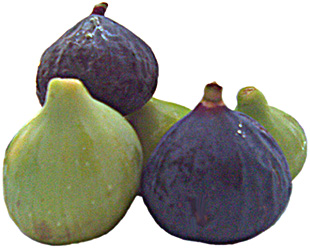...Best of Sicily presents... Best of Sicily Magazine. ... Dedicated to Sicilian art, culture, history, people, places and all things Sicilian. |
by Roberta Gangi | ||
Magazine Index Best of Sicily Arts & Culture Fashion Food & Wine History & Society About Us Travel Faqs Contact Map of Sicily |
Like almonds and olives, figs have an assured place in classical literature and the history of religion. The common fig (ficus carica) is native to western Asia and the eastern Mediterranean and, like artichokes (thought to be indigenous to Sicily), probably grew wild in Sicily during the earliest times. It was domesticated long ago, in numerous cultivars and varieties, initially by the first Neolithic farmers, and fossilised figs dated to circa 9400 BC (BCE) were discovered at one of the Gilgal village sites near Jericho. Two varieties of fig are cultivated in Sicily. The "Italian White" is actually yellowish green, while the "Italian Black" ripens to a deep purple. (Both are shown here.) They mature at about the same rate, and are ready to harvest beginning in late July. Undomesticated wild figs also grow in Sicily. The green fruit, though edible, ripens in late August or early September and is small, and relatively bitter, with a thick skin. Like the nobler cultivars, this is a small tree. While it is possible to propagate fig trees from seeds, shoots are the usual method. This means that, like most domesticated grape cultivars, domesticated fig trees are actually clones. Fig trees like water but can survive with little or no irrigation in coastal Mediterranean areas. Sunshine seems to sweeten the fruit, but a particularly dry summer may have a negative effect on production. Figs thrive in milder climates where the ground rarely freezes; some varieties are hardier than others. Often dried, figs are a good source of fibre, potassium, calcium and other minerals, as well as antioxidants. Buccelato, a Sicilian winter specialty, is a crust stuffed with figs and nuts. Turkey and Egypt are the top producers of figs today. Sicily produces figs primarily for local consumption. A noble fruit, and an ancient one. About the Author: Roberta Gangi has written numerous articles and one book dealing with Italian cultural and culinary history, and a number of food and wine articles for Best of Sicily Magazine. | |
Top of Page |
 When Cato the Elder
implored his fellow Romans to fight the
When Cato the Elder
implored his fellow Romans to fight the